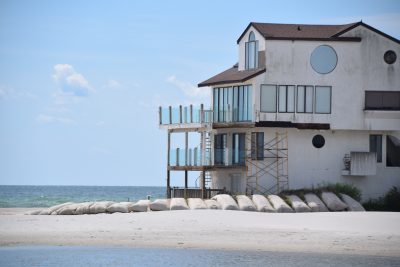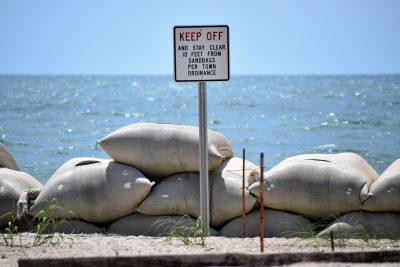
NORTH TOPSAIL BEACH – Property owners who settled a lawsuit late last year with the town will have to come up with more than one contractor’s proposal to repair the sandbag revetment put in place to ward off the ocean at the north end of the island.
Under the terms of the settlement, the 26 plaintiffs who brought the lawsuit against North Topsail Beach in May 2015 must submit at least two qualified engineers’ proposals for repairs to the sandbag revetment built to protect beachfront homes and condominiums from erosion.
Supporter Spotlight
For that reason, the town’s board of aldermen on Thursday night did not accept the sole contract proposal recently approved by a committee formed as part of the terms of the November settlement.
Members of the revetment committee include some of the plaintiffs in the case and representatives of the town. The plaintiffs are responsible for finding the minimum of two qualified engineers to submit contracts to do the job.
“We’re bound by the terms of the settlement,” Alderman Tom Leonard said during the town’s regular meeting Thursday. “We have one proposal. We cannot move forward and be compliant with the terms of the settlement agreement. There’s no choice if there’s only one. It’s a lot of money. It’s a big project. It’s important and it needs to be done right.”His motion to task town representatives on the committee to follow through with the terms of the settlement received a unanimous vote.
“I think you have a good point,” said Mike Benson, an aldermen and member of the committee. “With only having one proposal we don’t really know what the engineering cost is and whether it’s high or it’s low.”
Supporter Spotlight
All but one member of the six-person committee voted last month to recommend a contract proposal from Morehead City-based Arendell Engineers.
The civil engineering firm’s proposal includes the stipulation that the town sign a waiver stating it will not sue the firm or hold it responsible for any problems outside of issues directly caused by the engineer.
Arendell estimates the cost to survey, design, select a contractor and obtain permits for the work at about $50,000.

North Topsail Beach has been struggling for years to keep sand at the north end where the town abuts New River Inlet.
Shoreline erosion south of the inlet has been a persistent problem since 1984, the year the inlet’s bar channel shifted toward an alignment with Onslow Beach.
In response to the severe erosion, Topsail Reef Condominiums, a series of eight buildings overlooking the Atlantic on the north end, obtained a state permit in 2012 to install a sandbag revetment larger than the maximum the North Carolina Coastal Resources Commission, or CRC, typically allows.
The state in 2014 granted an extension to that permit.
That same year, the CRC gave the town permission to build a super-sized wall of sandbags spanning upward of 45 feet wide, 20 feet tall and extending 1,450 feet from the revetment in front of the condos.
The sandbags are there to provide temporary protection for oceanfront homes north of the Topsail Reef Condominiums and flood protection for a portion of New River Inlet Road.
The bags are permitted through 2022.
In October 2014 the town board voted to assess 39 property owners for half the cost of building the $1.4 million revetment. Those assessments ranged from $30,000 to $76,000.
The complaint 26 of those property owners made against the town, Carolina Marine Structures Inc., Coastal Planning & Engineering of North Carolina Inc. and Fish-Tec Inc., claimed the shoreline restoration project accelerated erosion.
The plaintiffs, which include former Mayor Fred Burns, charged that the project was poorly designed and constructed, made of inferior materials and that the sandbags were improperly placed.
“Despite starting with a design that was too small and too low, defendants then descoped the project, making the revetment even smaller, lower and sure to fail,” according to the complaint.
As part of the settlement, the plaintiffs will collectively pay $450,000 in assessments for the revetment project, a 45.3 percent reduction from the original assessment. Those funds will be coupled with the $200,000 the town has budgeted for the work.

The total budget for the project is $650,000.
The committee is supposed to aid the town in overseeing the third-party engineer’s work on the revetment, according to the settlement conditions.
Meanwhile, the town is in the process of obtaining federal and state permits to build a hardened erosion-control structure at the north end, which is another stipulation of the settlement.
Last month, representatives with Applied Technology and Management Inc., or ATM, the firm hired by the town to pursue a hardened structure project, suggested the town seek permits to build a 2,000-foot-long terminal groin.
ATM recommends the initial construction of a 1,500-foot terminal groin, which is a wall-like structure made of rock or other material placed perpendicular to the shore and adjacent to an inlet to control erosion.
An additional 500 feet of anchor could be added later if need be, engineers said.
A draft Environmental Impact Statement, or EIS, is being developed for the proposed project.
An EIS is a document that examines the positive and negative effects of a proposed project on the environment. Regulatory agencies use these documents, which are created by town-hired firms, as a tool to help determine whether to issue permits and what conditions, such as monitoring, to require in a permit.
Construction would cost an estimated $1.5 million and does not include moving an estimated 300,000 cubic yards of sand to stabilize the beach in conjunction with the structure.








